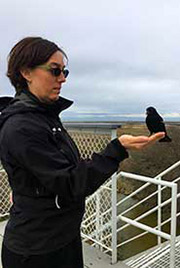Wild about chickens
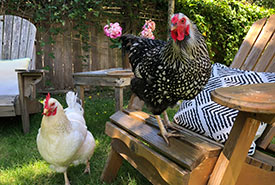
Lacy Mae and Matilda (Photo by LM Neilson/NCC staff)
Today it starts at 5:36 a.m. The rusty cackle slides in through my open window with the early morning light. I pause for a brief second to make sure I really heard the sound before opening my eyes and swinging my legs over the edge of the bed. The cackle sounds again, louder this time and with a hint of impatience. I have to move quickly now, lest it get out of hand and wake the neighbours. Their bedroom windows are mere metres from the disturbance. Morning has broken, and it’s time to let out the chickens.
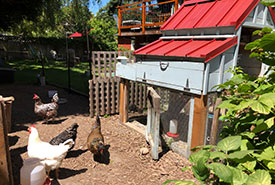
The ladies and their coop (Photo by LM Neilson/NCC staff)
The Marchioness Matilda von Benedict sprints down the ramp as soon as I open the coop door, with Fig hot on her heels. Lacy Mae manages a more dignified exit, as is her nature. I hear Marshawn thump down off the roost (she is the heftiest of the lot), and soon she squeezes out the coop door and joins her sisters in the yard. They run around my feet, a frantic tripping hazard, indecently eager for the few handfuls of oats I scatter on the ground.
This is my little urban flock. Four hens living their best life in my one-eighth of an acre on the edge of downtown Victoria, BC.
Halfway across the country, in Roseneath, Ontario, Val Deziel similarly rises with the sun to tend to her flock before heading out into the field as Nature Conservancy of Canada’s (NCC’s) coordinator of conservation biology for the Rice Lake Plains. Living in the country affords some freedoms — Val doesn’t need to worry about neighbours being upset at the sound of her birds, and her property has room for a far larger contingent of hens. She’s not even sure the exact count at the moment.
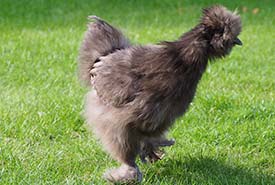
Silkie hen (Photo by NancyLiza, Flickr)
“I have a flock of about 20 Swedish flower hens, and then a separate silkie flock of about 10,” she says. The two breeds are kept separate so that the larger Swedish flower hens don’t beat up on the smaller silkies, which are a family favourite and, Val admits, a bit more like pets. Known for being friendly and good mothers, silkies are also aesthetically arresting, with big poofy feathers that make them look like they stepped out of a Dr. Suess storybook. As Val puts it, “They always look like they need a haircut and their pants hemmed!”
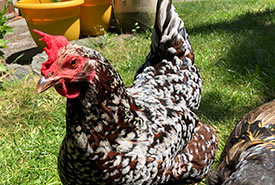
Marshawn the speckled Sussex (Photo by LM Neilson/NCC staff)
In our work at NCC, we spend a lot of time considering the needs of wild animals. We work to protect natural habitats so the wild creatures we would never invite into our homes – grizzly bears and badgers, owls and songbirds, salmon and turtles — can live their best lives as unhindered by humanity’s ever-expanding footprint as possible. Rarely does our conservation work need to consider the risks facing domesticated animals. However, due to the homogenizing effects of some industrial agriculture practices, there are species of domesticated animals that are threatened with extinction just the same as some of their wilder brethren.
This is where the heritage livestock conservation movement comes in. Many small-scale producers, hobby farmers and urban homesteaders are choosing to raise at-risk heritage breeds. Within the chicken world, this offers a huge variety of breeds to choose from, giving flocks genetic, temperamental and aesthetic diversity, as well as helping to ensure these breeds continue to exist.
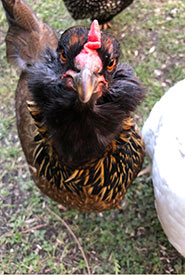
Fig looking dinosaur-ish (Photo by LM Neilson/NCC staff)
Here in my yard, as I type this, my ladies are roaming around picking seed heads off my overly long grass and helping control the invasive buttercup by digging for insects. It’s easy to tell the hens apart as they are all different breeds: Matilda, the Delaware (on the conservation Watch list), is white, Fig, an Ameracauna, is brown with black head feathers; Lacy Mae, a sliver laced Wyandotte, is a breed named for the black and white lacy pattern of the feathers; and Marshawn the speckled Sussex (formerly assessed as critical, now recovering), sports white-tipped brown feathers with hints of iridescent green. I can pay attention to the minutia of their features because there are only four, and these ladies are equal parts pets and egg-makers. (In fact, I can even tell who has laid which egg based on its colour. Fig’s blue eggs are the easiest to identify!)
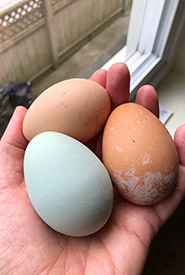
My hens produce colourful eggs (Photo by LM Neilson/NCC staff)
Val’s larger laying flock are Swedish flower hens, which are a rare, naturally evolved breed (as opposed to intentionally bred) that was brought back from the brink of extinction in the 1980s by Swedish preservationists. These brown and white speckled birds evolved naturally to adapt to the sometimes harsh climate of Sweden, but had been displaced by the rise of the mass-market poultry industry. It’s a fitting breed for Val and her family, who have nurtured a life in the country that prioritizes self-sufficiency and supporting local food security.
“I didn’t know I would like chickens so much,” says Val, who has been raising hens for about five years now. “If you have a good set up, then hens are a great addition to a household!”
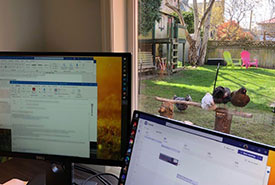
The view from my office (Photo by LM Neilson/NCC staff)
I’m coming to see that chickens may be the most underestimated of domesticated animals. Earlier today, my partner remarked at how he hadn’t expected the chickens to be so “good-looking.” He was expecting something more beastly and, perhaps, dinosaur-ish. Not only are the ladies pretty, they are funny and charming and instructive. Together, we forge an interspecies connection that is often missing in urban life. Their instincts are close to the surface — the way they stand stock still at attention when the occasional hawk cruises by (a threat that so far has not manifested in an attack and for which I take precautions). Their uncanny ability to find tiny insects in a seemingly uniform expanse of dirt. The ruthlessness of the pecking order.
Living with chickens — or any other non-human animal — offers us a chance to stretch beyond our current anthropocentric myopia and become attentive to reciprocal, positive relationships with the rest of the living world. This simple act can be a powerful antidote to the forces in our civilization that are leading us toward ecological destruction. That might sound overblown to some readers, but how else can we find our way to some sort of balanced existence on this living planet without deeply acknowledging, through direct experiences, our indisputable kinship with (and reliance on) the entire biosphere? The humble chicken is just one way to nurture such a relationship. What creatures in your life bring you down to earth?

